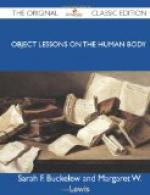What is enamel?—“A smooth, white substance, harder than bone.”
Of what use are the teeth?—“To eat and talk with.”
What kinds of teeth have you?—“Cutting teeth, tearing teeth, grinding teeth.”
Describe the cutting teeth.—“The cutting teeth have broad and flat edges.”
Describe the tearing teeth.—“The tearing teeth are sharp and pointed.”
Describe the grinding teeth.—“The grinding teeth are the thick, back teeth.”
Which jaw is moved in eating?—“The lower jaw.”
What work do the teeth perform?—“They cut, tear, and grind the food.”
How many teeth has a child in a full set?—“Twenty teeth: ten in each jaw.”
How many teeth has a grown person in a full set?—“Thirty-two: sixteen in each jaw.”
What does the tongue do in eating?—“It rolls the food between the teeth, and helps in swallowing.”
What is the saliva?—“A kind of liquid, sometimes called spit.”
Of what use is it in eating?—“It wets and softens the food.”
What do you mean by preserve?—“To keep from injury.”
What do you mean by injury?—“Hurt.”
How do you preserve your teeth? See Formula.
How do very hot or very cold drinks hurt the teeth?—“They crack the enamel.”
What happens if the enamel is cracked?—“The teeth decay.”
Then what must you do to preserve your teeth?—“I must try to keep the enamel from being cracked or injured in any way.”
* * * * *
PART V.
FORMULA FOR DESCRIPTION OF THE BONES.
1. My skull is formed of several bones united, like two saws with their toothed edges hooked into each other.
2. My spine extends from the base of the skull behind, down the middle of my back.
It is composed of twenty-four short bones, piled one upon the other, with cartilage between them.
These bones are fastened together, forming an upright and flexible column, which makes me erect and graceful.
3. My ribs are curved, strong, and light; there are twenty-four of them, twelve on each side; they are fastened at the back to my spine, in front to my breastbone, forming a hollow place for my heart, lungs, and stomach.
4. My shoulder blades are flat, thin, and like a triangle in shape; they are for my arms to rest upon.
5. My collar bones are fastened to my shoulder blades and my breastbone; they keep my arms from sliding too far forward.
6. The bones of old people are hard and brittle; those of children soft and flexible; so I must sit and stand erect, that mine may not be bent out of shape. I must not wear tight clothing, or do anything that will crowd them out of their places.
7. My bones are made from my food, after it has been changed into blood; so I must be careful to eat good, wholesome food, that they may be strong and healthy.




